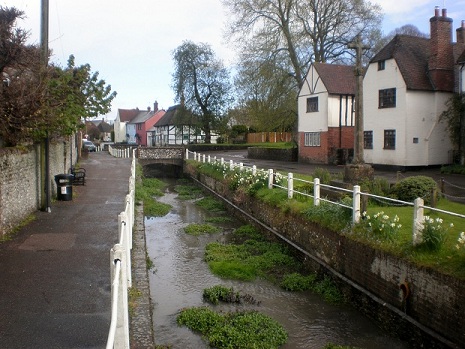By Tim Lambert
Early East Meon
In the 6th century AD, a people called the Meon from Denmark invaded central Hampshire. They settled in central Hampshire, and they gave the River Meon its name. They also founded the village of East Meon.
By the time of the Domesday Book in 1086, the manor of East Meon had a population of about 450. By the standards of the time, it was a large village (most Hampshire villages had a population of less than 150), and it must have been quite an important place.
In 2000, a woman found a Medieval ring in her garden at East Meon. It was made of a copper alloy and was gilded.
In the village of East Meon, 6 watermills ground grain into flour for the villages to make bread.
All Saints Church in East Meon was built in the early 12th century, although there must have been a church on the site much earlier. Additions were made to the church in the 13th century, and it has a black font made from marble from Belgium.
According to an old legend, King John married Isabella in All Saints Church in East Meon. (In those days, the parish of East Meon stretched from Hambledon to Steep).
In the Middle Ages, the manor of East Meon belonged to the Bishop of Winchester, and in the 14th century, he built his own courthouse in the village. However, by the 19th century, it was in a dilapidated condition.
In the 14th century, East Meon, like the rest of Europe, was devastated by the Black Death, and perhaps 1/3 of the population died.
According to legend, during the Civil War, in 1644, Royalists and Parliamentarians fought a skirmish in East Meon before the battle of Cheriton Down.
In the 1660s, a tax was placed on hearths. In East Meon, there were 59 households, so the population was probably less than 300. Of the households, nearly half (27) were exempt from paying the tax because of poverty. Most of them had only 1 hearth. Many families were living in huts of just one or two rooms. However, there were 2 affluent people in the village. William Randoll had 8 hearths and Thomas Randoll had 6.
Modern East Meon
In 1801, the population of the parish of East Meon was 1,061. (This figure includes both East Meon and the surrounding hamlets. The population of East Meon itself was several hundred). By 1851, it had increased substantially to 1,543. However, in the late 19th century, the population of East Meon and its hamlets declined slightly. In 1901, it stood at 1,533.
During the 18th century and the early 19th century, there was a workhouse in East Meon where the poor were put to work. However, in the 19th century, a workhouse in Petersfield replaced the one in East Meon.
In 1845, a national (Church of England) school was built in East Meon, and in 1863, almshouses were built in East Meon by Mrs Forbes.
For centuries, a fair was held at East Meon. (A fair was like a market, but it was held only once a year, and it attracted buyers and sellers from a wide area). However, the East Meon fair petered out at the end of the 19th century.
On 21 February 1920, a man named Harry Silvester discovered the body of a naked man lying in a field beside the Petersfield to Winchester Road. The man’s identity was never discovered.
Leydene House was built in 1924. In 1949, the Admiralty bought it and turned it into HMS Mercury. In 1927, the Court House was restored. Then, in the 1950s, to prevent flooding the council deepened the river and concreted its bed. The bridges were raised. East Meon Village Hall officially opened on 8 February 1975.
In the 1960s, East Meon and its surrounding area grew rapidly as many commuters went to live there. By 1970, the East Meon area had a population of about 1,725. East Meon itself had a population of around 800. Today, the population of East Meon itself is nearly 1200.
